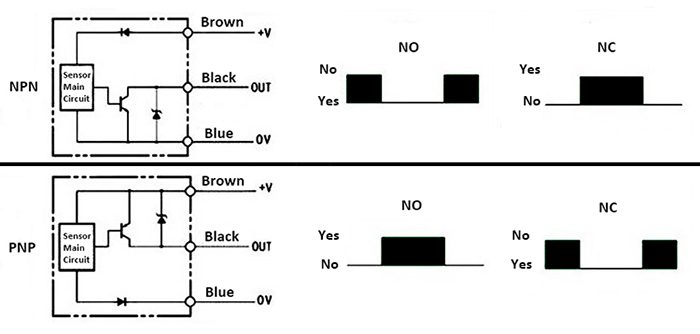Difference between PNP and NPN Proximity Sensor
Proximity sensors are known as non-contact travel switches which are generally widely used in material sorting control systems and automatic detection. Proximity sensors are divided into inductive proximity sensor, capacitive proximity sensor, magnetic proximity sensor, analog proximity sensor and Hall proximity sensor, which can detect whether there is an object approaching within a range of several millimeters to tens of millimeters. When the distance between the object and the proximity switch reaches a certain range, this proximity sensor can send out the corresponding action signal. The core of the proximity switch is the sensing head, which has a high sensing ability for approaching objects.
Proximity sensors have PNP and NPN signal outputs. But what are the differences between them?
High and low levels of PNP and NPN output signals are different
PNP type means that the signal output terminal outputs a high level output, and the internal switch is connected between the signal terminal and the positive pole.
- NO: The signal terminal is usually low level, when there is a signal input, the signal terminal is high level (positive) output.
- NC: The signal terminal is usually high level, and when there is a signal input, the signal terminal is low level (negative) output.
NPN type means that the signal output terminal outputs a low level output, and the internal switch is connected between the signal terminal and the negative pole.
- NO: The signal terminal is usually high level, when there is a signal input, the signal terminal is low level (negative) output.
- NC: The signal terminal is usually low level, when there is a signal input, the signal terminal is high level (positive) output.

Wiring of PNP and NPN are different
The following is an example of a proximity sensor with 3-wire output. If the proximity sensor is PNP type, the black wire and the blue wire are connected to the negative pole of the power supply. When the proximity switch is activated, the blue wire and the brown wire are connected so that the two ends of the load can receive a signal. If the proximity sensor is NPN type, the black wire and the brown wire are connected to the positive pole of the power supply in parallel. When the proximity switch is activated, the blue (negative) wire and the black wire are connected to get a signal at both ends of the load. The wiring diagram is shown below.


